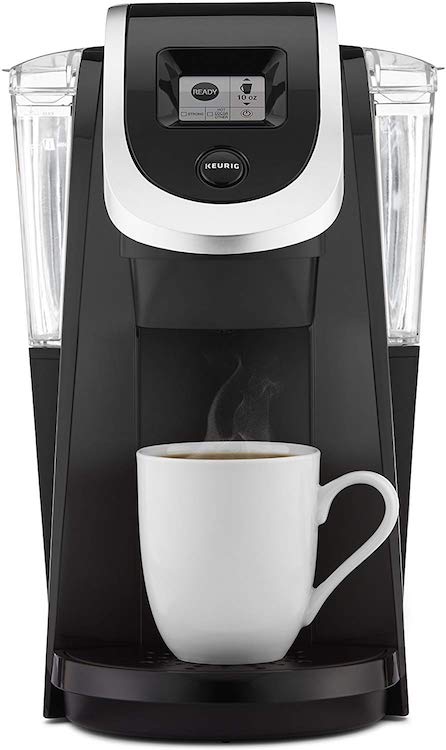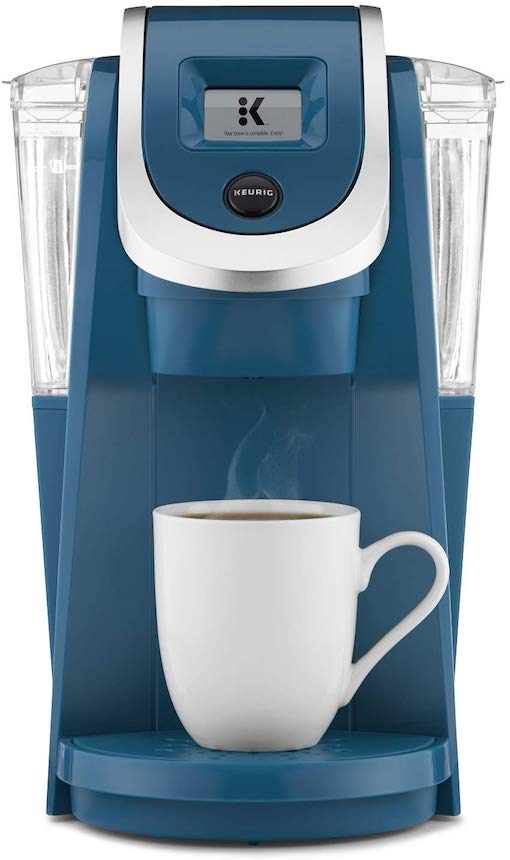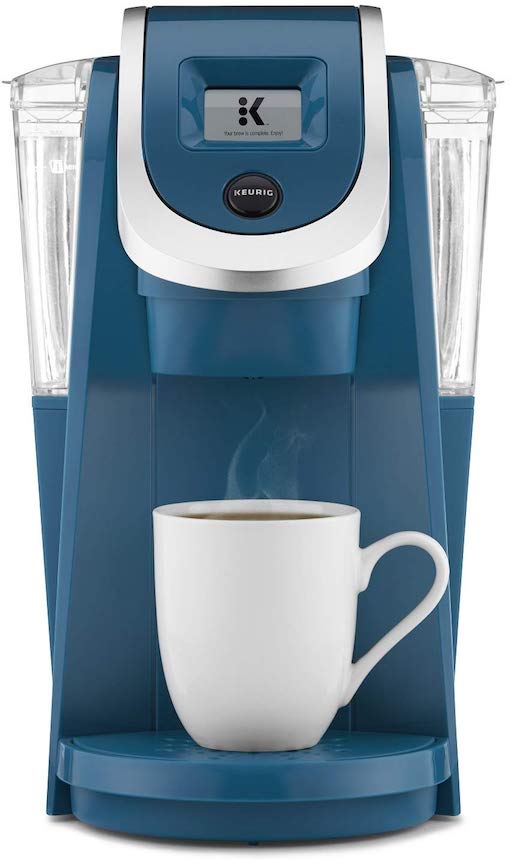CoffeeVerdict is reader-supported. When you buy through links on our site, we may earn an affiliate commission. Thanks!
In the past few years, Keurig has had to discontinue a number of its K2.0 coffee makers. Among those that have been spared include the iconic K200 and K250 that seem to impress coffee fiends the most.
If you are eyeing either of these coffee makers, you’ll be hard-pressed to tell the difference between them. This is because, from a glance, they are the same machine that is sold under different names.

Keurig K200 Black 
Keurig K250 Blue
Wait, what’s the purpose of using different names for the same product? Well, this is quite common with Keurig and several other coffee maker brands that have a long catalog of brewers.
Most K250 vs K200 critics say that this is a marketing strategy to increase sales by riding on the success of an existing product.
However, although seemingly identical in pretty much all fronts, several sources claim that these models are genuinely different brewers.
In that case, our team at CoffeeVerdict sat down to answer the one million dollar question of all time: what are the differences between Keurig K200 vs K250 coffee machines?
Here are our findings and verdict.
Keurig K250 vs. k200: Comparison Table
| Keurig K200 | Keurig K250 | |
| Size | 8.9 (w) x 13.8 (d) x 13.6 (h) inches | 9 (w) x 15 (d) x 13.7 (h) inches |
| Weight | 8.8 pounds | 7.5 pounds |
| Water Reservoir Capacity | 40 oz | 40 oz |
| K-Cup compatibility | K-cup, K-Carafe, and K-Mug pods | K-cup, K-Carafe, and K-Mug pods |
| Brew Size | 7 (manufacturer states 9) | 7 (manufacturer states 9) |
| Auto-Off | No | No |
| Activated Charcoal filter | Uses a filter. None included in package | 2 filters included in package |
| Brew speed | 1 cup/minute | 1 cup/minute |
| Noise level | Relatively quiet | A tad noisier |
| Brew customization | Yes | Yes |
| Price | $ (Buy on Amazon) | $$ (Buy on Amazon) |
Comparison Overview
Keurig released the K250 as an improved version of the K200, which was already doing well in the market. However, upon close inspection, our CoffeeVerdict review team was left with more questions than answers on a few critical issues.
For instance, when you search K250 on Keurig’s website, why are you directed to the company’s list of discontinued products? Could it be that the Keurig K250 is actually a discontinued model, but the manufacturer is shy to reveal? Again, why is there not a single mention of this new product at Keurig.com despite it being one of the best-rated coffee makers on Amazon in 2020?
While Keurig is yet to clarify these issues, our team’s comparison of the Keurig K200 and Keurig K250 coffee makers may help answer some of these questions.
K200 vs K250 Coffee Makers: Differences, Similarities, and Reviews
Look and Build
One of the most confusing aspects that you’ll find in most K200 vs K250 comparisons in 2020 is the size of these brewers. We’ve seen several sources stating that they have the same measurements and weight and others suggesting otherwise. Reviews on Amazon haven’t been of great help too. Even worse, Keurig offers almost no information about this on their website as well as in the manual.
So, what is the difference between the K250 and K200 Keurig with regard to size?
These coffee makers appear to be of the same size when placed side by side, but the difference shows once you get a tape measure.
The Keurig K200 has a width of 8.9’’, a depth of 13.8’’ and a height of 13.6’’. It is notably slightly smaller on all sides than the Keurig K250 that measures 9 (w) x 15 (d) x 13.7 (h) inches. Conversely, the K200 that weighs 8.8 pounds is a tad heavier than the K250 that weighs around 7.5 pounds.
The minuscule difference in these coffee makers’ size and weight could be regarded as insignificant. However, the fact that you’ll require a height clearance of around 20’’, and a depth of at least 17 inches means that they are relatively bulkier.
Again, this minute difference in measurements tends to partly confirm Keurig’s claim that these 2 are different machines. There are still lots of factors to consider, though. Let’s go on.
Aesthetics
These brewers are very similar in looks. They boast the unmistakable design of the new Keurig coffee machines featuring a large white and black touch-sensitive LCD and an enormous ‘brew’ button atop the head. Although opinions vary as far as aesthetics go, most people say that these machines are ‘‘beautiful’’ and ‘‘nice-looking’’ on their kitchen counters.
Another outstanding similarity in this Keurig K250 vs K200 comparison is the available colors. These brewers come in 11 different colors, although most sellers on Amazon stock 7-9. These are still enough to offer everyone a tone that will resonate with their kitchen design, though.
Comparing Keurig K250 vs K200 Brew Quality
Trying to tell the difference in brew quality between 2 k-cup coffee makers can be an uphill task, especially when the machines are seemingly similar. This appears to be the case with the K200 vs K250 Keurig.
Both of these brewers reach the ideal brewing temperatures of between 195 and 205 F. When loaded with similar coffee pods and used at same settings, they tend to deliver identical tastes and flavors.
Although the Keurig K250 and K200 don’t allow brew temperature customization, we haven’t come across significant complaints about the drink being annoyingly hot or cold on Amazon and Keurig’s website.
The 2 other critical determinants of brew quality are water purity and ability to customize the strength of your coffee.
Concerning water purity, both of these coffee machines will come with an optional water filter. If you are supplied with non-filtered water, this filtration kit will help in removing most of the water contaminants that may alter with the overall taste of your coffee. You don’t have to use this filter if you primarily use bottled water in your kitchen or if your water is filtered.
Again, each of these coffee makers has a ‘Strong’ button that intensifies the strength of your coffee. It does so by increasing the length of time that the hot water is in contact with the puck.
Let’s compare Keurig K250 Keurig vs k200 K-cup compatibility!
The K200 and K250 coffee machines come from Keurig’s new line of coffee makers dubbed K2.0. This new line was started after Keurig’s patent on K-cup pods expired in 2012.
The K2.0 brewers only allow you to use Keurig -branded coffee brands and technically locks out 3rd party brands. The Keurig Green Mountain is a giant company, though, and offers you 350+ coffee pod varieties to experiment with. This means that while your coffee maker will only be compatible with K-cup pods, you will still have endless options to explore.
Generally, seeing that Keurig K200 and K250 tend to brew at the same temperature range and can support similar K-cup pods, the similarity in brew quality is not surprising.
Lastly, and something that most people will love, these coffee machines also support the reusable My K-Cup filter. This means that you are not tied to coffee pods, but you can as well grind and brew your coffee.
Strength, Durability, and Reliability
The Keurig K200 and K250 use plastics for most of their construction. Actually, pretty much all the major components from the shell to the water reservoir and brewing chamber are plastic. This could be viewed as Keurig’s way of cutting down on production costs.
The plastics used for these coffee machines don’t appear cheap. However, a closer inspection shows that they are not heavy gauge and may, therefore, break easily if mishandled. We rarely come across complaints about any of these components breaking prematurely unless regularly dropped, though.
Again, there are replacement parts for the water reservoir and drip tray for both machines. All in all, we expect these coffee makers to last around the same time.
What about reliability?
Durability and reliability are 2 different aspects in this K200 vs K250 debate. While durability talks about the length of the coffee maker’s life, reliability refers to the likelihood that it won’t fail when least expected.
Again, the best way to find out the difference between the Keurig K200 vs K250 in terms of reliability was to turn to previous buyers’ reviews on Amazon and Keurig.com.
From our findings, reliability seems to be a significant issue with these 2 coffee makers. Unfortunately, the K250, in particular, seems to score the lowest marks in this department.
Most K200 owners report that the machine works well for close to a year before error messages start showing on the LCD. In most instances, this issue is caused by clogged up water entry needles that lead to low water pressure. This can be easily solved by using a straightened paper clip to loosen stuck grounds and a water-only brew cycle.
The Keurig K250 also seems to have the same issue only that it arises much earlier and more frequently. Another complaint regarding this model (although not so common) is that it keeps passing coffee grounds into the cup.
Reliability in coffee machines is dependent on how well you maintain it and keep it clean. However, comparing Keurig K200 vs K250, the former, is the clear winner here.
Comparing the K200 and K250: Ease of Use
Ease of use is generally the name of the game with these Keurig coffee makers. Both of them thrive on the ability to pull a cup of coffee in under 1 minute.
You don’t need to fiddle around with temperature adjustment settings or water measurements since these have been automated.
The K200 and K250 combine a large touch-sensitive LCD and large unmissable brew button for its control interface.
From the digital touchscreen, you can choose to brew 4, 6, 8, and 10-ounce sizes using regular K-cups. There’s also a strength control option if you prefer strong coffee. Using a K-carafe pod, you can choose to brew 2-3 cups or 4-5 cups. Lastly, if you like coffee-on-the-go, you can remove the drip tray and use a K-mug pod to brew into your favorite traveling coffee mug.
In total, these coffee machines offer 7 brew sizes, including the carafe and mug brew sizes. Keurig claims that they allow 9-10 brew options. We aren’t exactly sure what the 2-3 additional brew sizes are, so share with us once you find out.
Keurig K250 vs K200: Cleaning and Maintenance
Keurig brewers’ cleaning and maintenance processes are generally straightforward, and it’s not different with the K200 and K250.
The only critique that we have here is that these 2 models lack the descale alert feature that we find on other Keurig coffee machines.
Keurig recommends descaling these machines every 3-6 months. However, considering how sensitive their systems are to clogged needles, CoffeeVerdict suggests doing so monthly or even bi-monthly to keep the maker in good shape. You’ll also detect that your device needs descaling once you start seeing residues in your coffee. A machine that suddenly begins to brew half cups is also alerting you on the need for urgent cleaning.
Another maintenance requirement that these makers require is filter replacement. The Activated Charcoal filters should be replaced after 3-6 months.
The K250 will come with Keurig’s coffee maker descaling solution and a pair of activated filters. The K200 comes with none of these and should, therefore, be bought separately.
How to clean the Keurig K200 or K250
You’ll need;
- Coffee machine descaling solution or vinegar
- Soapy, warm water
- Lint-free piece of cloth
How to clean your machine
- Take out all the removable parts (drip holder, water reservoir, and k-cup holder) and wash them in warm, soapy water and rinse them. None of these are labeled as dishwasher-safe, so we’d recommend that you wash them by hand. The K-cup holder has 2 sharp needles. Remember to handle it with care.
- Using a wet cloth, wipe off the exterior of the coffee machine.
- Lastly, reassemble all the parts that you removed.
How to descale Keurig K200 and K250 coffee makers using descaling solution and vinegar
Using the descaling solution
What you’ll need;
- A large mug (ideally 12oz).
- Freshwater.
- Access to a sink.
Procedure
- Starting with an empty water reservoir and with the water filter removed, pour all the contents of the descaling solution into the water tank.
- Fill the tank with water to the MAX line.
- Place a large mug on the drip tray and run a hot water cycle using the largest brew size. Empty the mug.
- Repeat this until the ‘add water’ alert is displayed. Let the machine stay for around 30 minutes. This allows the descaling solution to work on the limescale.
- After 30 minutes, fill the water reservoir again and run several rinsing cycles to remove all the descaling solution. You might want to fill the water reservoir twice.
Using white vinegar
What you’ll need:
- At least 30oz of white vinegar.
- Water.
- A large mug.
- Access to a sink.
Procedure
- Remove the water filter first (that is, if you had installed it).
- Pour the white vinegar to the empty water reservoir.
- Add fresh water to top up the vinegar to the MAX line.
- Place the mug on the drip tray and run a hot water cycle using the largest brew.
- Repeat this process until all the water in the reservoir is depleted.
- Let the machine stand for 3-4 hours for the vinegar to work on the scale.
- Add fresh water in the tank up to the MAX line.
- Run hot water cycles using the largest brew size to remove the vinegar from the system. It might be necessary to refill the water reservoir and run additional rinse cycles to remove any residual taste.
Verdict
In a nutshell, these coffee makers are incredible choices if you are after convenience, speed, and ease of use. They also offer lots of brew size options, which is great if you’ll be brewing a single cup at one time, and a full carafe the next minute.
So, what are the differences between Keurig K200 vs K250? Honestly, we didn’t find any major differences between these 2 coffee makers. They tend to brew at the same speed, and their brew quality is identical.
Why then are they sold under different names? Only Keurig can answer this correctly, but perhaps the secret is on the accessories that each package comes with. The K250 comes with a pair of activated carbon filters to last you close to 1 year, a set of coffee pods to kick you off, and a bottle of Keurig descaling solution. On the other hand, the K200 does not come with any of these.
At the end of the day, and in our opinion, your choice between the Keurig K250 vs K200 will largely depend on your budget. The K200 is cheaper. However, its price tag tends to get a little bit higher once you add the additional cost of the extras.
On the other hand, the K250 is slightly pricier, but its price is reasonable once you factor in all the accessories that you are getting with the package.
CoffeeVerdict Recommends:
Although there are virtually no differences between these machines, we’d go with the older model- the K200. Besides being cheaper, this machine seems to be Keurig’s favorite, considering that it’s the only one that has been listed on their website. This means that there’s a higher likelihood of getting support with this model than with the K250.
Frequently Asked Questions
In most instances, this is caused by a clogged up needle. Use a straightened paper clip to free up stuck coffee grounds and run a water-only brew cycle.
Similar to other Keurig machines, these models use 1500 watts when heating the water for the first time. For the subsequent brews, they will use 200-400 watts only thanks to an internal water tank that holds water up to temperature.
Keurig suggests once every 3-6 months. The CoffeeVerdict team recommends descaling monthly, especially if your tap water is unfiltered.
- Keurig K250 vs. k200: Comparison Table
- Comparison Overview
- K200 vs K250 Coffee Makers: Differences, Similarities, and Reviews
- Look and Build
- Comparing Keurig K250 vs K200 Brew Quality
- Let’s compare Keurig K250 Keurig vs k200 K-cup compatibility!
- Strength, Durability, and Reliability
- Comparing the K200 and K250: Ease of Use
- Keurig K250 vs K200: Cleaning and Maintenance
- How to clean the Keurig K200 or K250
- How to descale Keurig K200 and K250 coffee makers using descaling solution and vinegar
- Verdict
- CoffeeVerdict Recommends:
- Frequently Asked Questions



